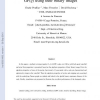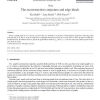112
click to vote
JCT
2011
14 years 3 months ago
2011
Abstract. Norton and Stein associated a number with each idempotent quasigroup or diagonalized Latin square of given finite order n, showing that it is congruent mod 2 to the tria...
132
click to vote
TCOM
2008
14 years 11 months ago
2008
In this paper, a method to design regular (2, dc)-LDPC codes over GF(q) with both good waterfall and error floor properties is presented, based on the algebraic properties of thei...
113
Voted
ORDER
2006
15 years 17 days ago
2006
We investigate ways of representing ordered sets as algebras and how the order relation is reflected in the algebraic properties of the variety (equational class) generated by the...
82
Voted
DM
2008
15 years 21 days ago
2008
Given a simple graph G on n vertices, we prove that it is possible to reconstruct several algebraic properties of the edge ideal from the deck of G, that is, from the collection o...
98
Voted
CORR
2010
Springer
15 years 22 days ago
2010
Springer
Type-flaw attacks and multi-protocol attacks on security protocols have been frequently reported in the literature. Heather et al. and Guttman et al. proved that these could be pr...
88
Voted
EUSFLAT
2003
15 years 2 months ago
2003
We discuss the algebraic properties of intuitionistic fuzzy implications. We examine the conjugacy problem in this family of functions. The characterizations of intuitionistic fuz...
118
Voted
CSFW
2009
IEEE
15 years 4 months ago
2009
IEEE
ProVerif is one of the most successful tools for cryptographic protocol analysis. However, dealing with algebraic properties of operators such as the exclusive OR (XOR) and Diffie-...
111
Voted
ICALP
2010
Springer
15 years 5 months ago
2010
Springer
Abstract. We prove a new congruence result for the π-calculus: bisimilarity is a congruence in the sub-calculus that does not include restriction nor sum, and features top-level r...
105
Voted
LPAR
2005
Springer
15 years 6 months ago
2005
Springer
Abstract. Many security protocols fundamentally depend on the algebraic properties of cryptographic operators. It is however difficult to handle these properties when formally anal...
127
Voted
WISTP
2009
Springer
15 years 7 months ago
2009
Springer
Abstract. This work aims to identify the algebraic problems which enable many attacks on RFID protocols. Toward this goal, three emerging types of attacks on RFID protocols, concer...








